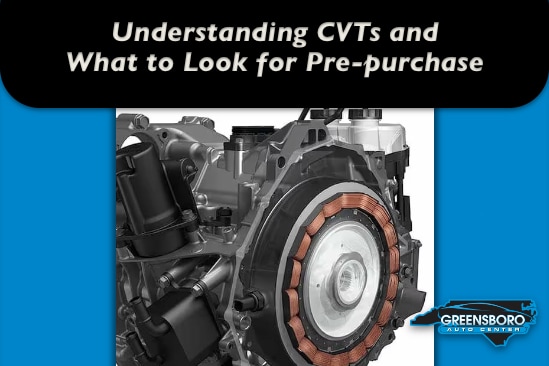
Continuously Variable Transmissions (CVT) have been widely adopted by manufacturers worldwide, they can offer excellent fuel efficiency and a remarkably smooth driving experience, making them an attractive option for those in the market. Though prevalent now, their exponential growth has only happened over the past two decades, with new-tech growing pains having understandably caused alarm that carries on today. As a significant vehicle component, it's wise to understand what makes it tick and what to look for during your buying process, so today, we’re here to help you make an informed decision - let’s get into it!
How a CVT Transmission Works (Basically)
Unlike traditional automatic transmissions that use a fixed set of gears, a CVT is designed to provide the equivalent of an infinite (not really, but A LOT) number of "gear ratios" within a specific range, rather than distinct steps. This allows the engine to always operate at its most efficient RPM (revolutions per minute) for any given speed or load within the full spectrum of its bandwidth of power.
As you shop you may notice CVTs of different flavors, and while the fundamental goal is the same, they achieve this continuous variability through different mechanical designs:
- Belt-and-Pulley CVTs: This is the most common type found in many conventional gasoline-powered passenger cars, and so the most likely design you’ll come across. It uses a flexible belt, or chain, running between two variable-diameter pulleys. As the pulleys adjust, the effective "gear ratio" changes seamlessly. Think of it like a 10-speed bike, then imagine the rear cassette gears are a cone, while the gears of the pedal crank are another cone, both connected by a belt which constantly “shifts” or adjusts itself to the perfect “gear” or position on both cones to most efficiently deliver power for any incline or speed.
- eCVTs (Electronic Continuously Variable Transmissions): Predominantly found in hybrid vehicles (such as those from Toyota, Lexus, Ford, and others), these systems operate quite differently. Instead of belts and pulleys, they typically use a planetary gear set combined with electric motors and generators. The electronic control of these components is what creates the continuously variable effect, managing power flow from the engine and electric motors to the wheels. This design is widely recognized for its robust reliability.
- Other Variations: While less common in mainstream passenger vehicles, some manufacturers have explored other designs, such as toroidal CVTs (using rotating discs and rollers) or even specialized multi-mode hybrid systems that blend fixed gears with electric power for continuous effect.
For the used car buyer, the key takeaway is the continuous nature of the power delivery, regardless of the internal mechanism. Ultimately, this continuous adjustment means smoother acceleration, as there are no traditional "shifts" between distinct gears, and this efficiency of operation often translates to better fuel economy further keeping the engine in its most optimized operating range.
CVT Advantages
The CVT popularity boom has been for good reason, as they offer several key benefits:
- Exceptional Fuel Efficiency: This is often the biggest draw. As we’ve already highlighted, CVTs can significantly boost gas mileage compared to traditional automatics.
- Seamless Acceleration: Since there are no "shifts" between fixed gears, acceleration is incredibly smooth and continuous, no jerking or lurching as you put the pedal to the metal.
- Often More Compact: Their design can allow for lighter and more compact transmission units, decreasing inertia while also increasing design flexibility.
- Ideal for City Driving: Their smooth, efficient operation makes them particularly well-suited for stop-and-go city traffic.
The Evolution of CVTs: Getting rid of the Gremlins
As with any new tech, earlier generations, particularly from certain manufacturers in the 2000s and early 2010s, faced some well-documented reliability issues, giving CVTs a bad first impression for many buyers. Like any evolving technology though, CVTs have seen significant advancements over the past decade. Automotive engineers have made vast improvements in materials, design, and control software. Modern CVTs from many manufacturers are now highly refined and, as with any part of your powertrain, combined with proper maintenance, can offer reliable long-term performance. That said, let’s look at…
What to Keep an Eye Out For When Shopping for a Used Car with a CVT
Knowing that modern CVTs are more reliable, they still have a unique driving experience, so what do you look for? It all comes down to doing your due diligence, so here’s a simple checklist:
The "Feel" Test:
- Smooth Acceleration: The car should accelerate smoothly and consistently, without any jerking, hesitation, or a "slipping clutch" feeling.
- Unusual Noises: Listen for excessive whining, droning, or grinding sounds, especially during acceleration or deceleration. A light, consistent whine can be normal for some CVTs, but anything loud, harsh, or inconsistent is a big red flag.
- Consistent RPMs: While accelerating steadily, the engine RPMs should rise and fall smoothly, or stay somewhat constant as the vehicle gains speed. Wild, unexplained RPM fluctuations – without corresponding speed changes – can indicate an issue.
- Response to Throttle: Does the car respond predictably when you press the gas pedal, or does it feel delayed or disconnected?
Vehicle History Report (VHR):
Always request and review a comprehensive vehicle history report (like CARFAX or AutoCheck). Look for any signs of major transmission repairs, replacements, or significant accidents that could impact the drivetrain, and don’t be afraid to ask questions. Crucially, look for regular maintenance entries. For CVTs, consistent transmission fluid changes are paramount. If maintenance records are spotty or non-existent, proceed with caution.
Check for Leaks/Smells:
After a test drive, take a moment to look for any fluid leaks under the car. Also, sniff around the transmission area for any burning smells, which could indicate overheating or other problems.
Confidently Choosing Your Next Used Car
Ready to explore your options? Browse our inventory of thoroughly inspected used cars, many of which feature efficient CVT transmissions. Our team is ready to answer your questions and help you find the perfect vehicle for your lifestyle and budget.